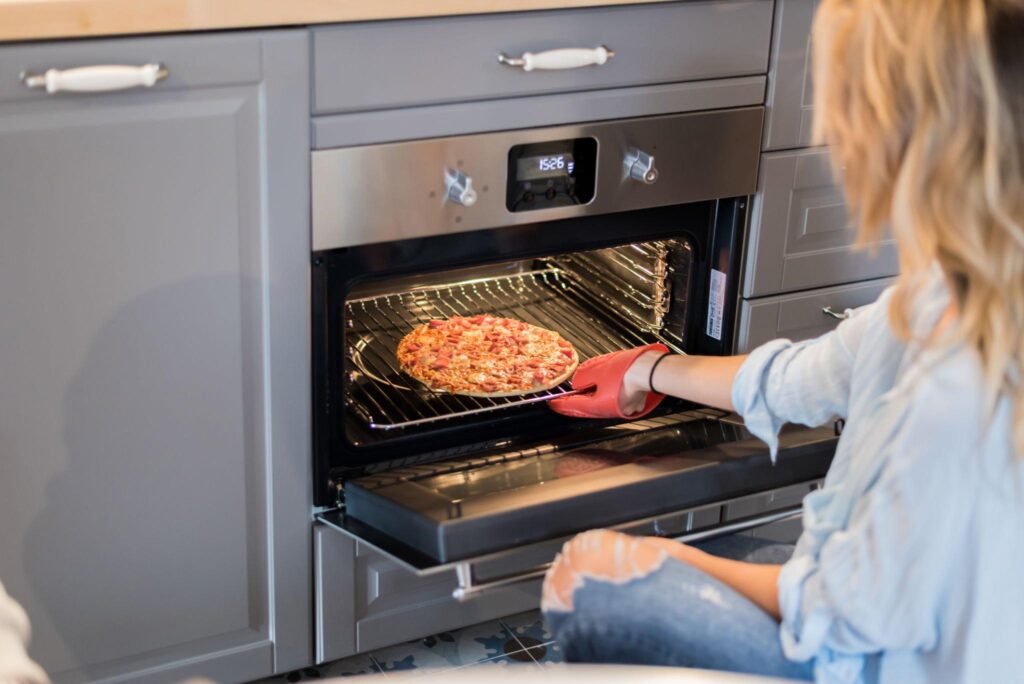Introduction To Pizza Ovens
Who doesn’t love a delicious, piping-hot pizza straight out of the oven? Pizza ovens are a crucial part of the pizza-making process, and understanding how they work can help you achieve that perfect slice. So, how do pizza ovens work? We will dive into the fascinating world of pizza ovens and explore the science behind their cooking techniques.
The History Of Pizza Ovens
Pizza ovens have been around for centuries and have evolved significantly over time. The origins of the traditional pizza oven can be traced back to ancient Pompeii, where they used wood-fired ovens to cook their bread. These ovens were made of stone or clay and relied on the intense heat produced by burning wood to cook the dough and toppings quickly.
Over the years, pizza ovens have undergone various advancements. Today, you can find different types of pizza ovens, including wood-fired, gas-fired, and electric options. Each type has its unique qualities and methods of heating, but they all aim to achieve that perfect crispy crust and gooey cheese.
The Basics Of Pizza Oven Cooking
So, how do pizza ovens work? The magic lies in their ability to reach high temperatures quickly and evenly distribute that heat. Here’s a breakdown of the basic process:
- Heating the Oven: The first step is to heat the oven to the desired temperature. Traditional wood-fired ovens can reach temperatures as high as 900°F (480°C) or more, while gas-fired and electric ovens typically have adjustable temperature settings.
- The Cooking Surface: Pizza ovens feature a cooking surface made of refractory materials, such as stone or brick. These materials absorb and retain heat, allowing the pizza to cook evenly from both the top and bottom.
- Quick Cooking: Once the oven is hot and the pizza is placed on the cooking surface, the intense heat quickly cooks the dough, resulting in a crispy crust. The high temperatures also cause the toppings to cook rapidly, ensuring the pizza is cooked perfectly in just a few minutes.
- Optimal Airflow: Pizza ovens typically have a chimney or vent to regulate airflow. This helps control the heat distribution and prevents the pizza from burning. Proper airflow is crucial to achieving that ideal crispy crust and melted cheese balance.
Understanding the science behind pizza ovens allows you to experiment with different cooking techniques and temperatures to create your perfect pizza. Whether you prefer a classic Neapolitan-style pizza from a wood-fired oven or a quick and convenient option from a gas or electric oven, the principles remain the same – heat, speed, and even cooking.
Now that you understand how pizza ovens work better get ready to unleash your creativity and enjoy the delightful art of homemade pizza-making!
Types Of Pizza Ovens
Traditional Wood-fired Pizza Ovens
When it comes to achieving that authentic, flavorful taste, traditional wood-fired pizza ovens are the way to go. These ovens use burning wood as their heat source, imparting a smoky flavor to the pizza and providing even heat distribution. The high temperature the burning wood generates allows the pizza to cook quickly, resulting in a crispy crust and perfectly melted toppings. Additionally, the wood-fired ovens create a unique ambiance, with the mesmerizing flames and aroma creating an unforgettable experience for customers.
Gas Pizza Ovens
If convenience and efficiency are important to you, gas pizza ovens are an excellent choice. These ovens use natural gas or propane as the main fuel source, providing a consistent and controlled heat supply. Gas ovens offer precise temperature control, allowing chefs to adjust the heat quickly and easily. The even heat distribution in gas ovens ensures that the pizza cooks evenly, creating a perfect balance between the crust, toppings, and cheese. With faster cooking times and less maintenance than traditional wood-fired ovens, gas pizza ovens are a popular choice for many pizzerias.
Electric Pizza Ovens
Electric pizza ovens are worth considering for those looking for a more cost-effective and versatile option. These ovens use electricity to generate heat, making them easy to install and operate. Electric ovens offer exceptional temperature control and consistent heat distribution, ensuring that your pizza cooks evenly every time. With the ability to adjust temperature and cooking time, electric ovens allow for a wide range of pizza styles and crust thicknesses. While they may not give the same smoky flavor as wood-fired ovens, electric pizza ovens are a practical and efficient choice for busy commercial kitchens or home use.
How Pizza Ovens Work?
Heat Sources And Temperature Control
Pizza ovens are designed to cook pizzas quickly and evenly. The secret lies in their heat sources and temperature control mechanisms. Traditional pizza ovens use wood, while modern ones may use gas or electric heating elements. Wood-fired ovens provide heat and give pizza that unique smoky flavor. Gas and electric ovens offer more controlled heat and faster cooking times.
Temperature control is crucial for achieving the perfect pizza. Pizza ovens are equipped with thermometers to monitor the internal temperature. The ideal cooking temperature for a pizza is around 800°F (427°C). This high heat ensures a crisp and evenly cooked crust, while the toppings are cooked to perfection.
The Importance Of Pizza Stones
One key element of pizza ovens is the pizza stone. The pizza stone is a thick, porous slab made of materials like ceramic or cordierite. It helps distribute heat evenly and absorb moisture from the pizza dough, resulting in a crispy crust. The stone also retains heat, allowing for consistent cooking throughout the baking process.
A pizza stone needs to be preheated along with the oven to use. This ensures that the stone is hot and ready to cook the pizza as soon as it is placed on top. Some pizza stones also require periodic seasoning to prevent sticking and maintain their quality.
Airflow And Convection Cooking
Proper airflow is essential for a well-cooked pizza. Pizza ovens have vents or chimneys that allow for the regulation of airflow. This circulation helps remove excess moisture from the oven, preventing a soggy crust.
Convection cooking is another factor that contributes to the pizza’s perfection. In convection cooking, the heated air circulates around the food, cooking it more evenly and quickly. Some pizza ovens come with built-in convection fans, while others rely on the natural convection created by the design of the oven.
In conclusion, pizza ovens work by harnessing the power of heat sources, temperature control, pizza stones, airflow, and convection cooking. Each element plays a crucial role in creating the delicious and crispy pizzas we all love. Whether you prefer the traditional wood-fired taste or the convenience of modern gas or electric ovens, understanding how pizza ovens work can help you achieve pizza perfection in your own kitchen.
The Science Of Pizza Oven Cooking
The Maillard Reaction And Crust Development
Have you ever wondered why pizza crust turns golden brown and develops a delicious flavor? It’s all thanks to the Maillard reaction, a chemical reaction that occurs during baking. The Maillard reaction is a complex process that involves the reaction between amino acids and sugars in the dough when exposed to high heat.
The Maillard reaction begins when the pizza dough goes into the hot oven. As the temperature rises, the amino acids and sugars in the dough react to form new compounds that give the crust its signature color and taste. This reaction produces sugar caramelization, creating a crispy and flavorful crust.
Oven Spring And Yeast Activity
Another important scientific aspect of pizza oven cooking is oven spring and yeast activity. Yeast is a key ingredient in pizza dough, producing carbon dioxide gas during fermentation. When the dough is placed in a hot oven, the heat causes the gas bubbles to expand, resulting in what is known as oven spring.
The oven spring process is crucial in creating a light and airy crust. The heat causes the yeast to become more active, accelerating fermentation and promoting the production of carbon dioxide gas. This gas gets trapped in the dough, causing it to rise and create those sought-after air pockets in the crust.
Melting Cheese And Toppings
Lastly, let’s not forget about the melting cheese and toppings on a perfectly cooked pizza. The cheese starts to melt when the pizza is placed in the hot oven. The heat causes the proteins in the cheese to break down, creating a smooth and gooey texture.
As for the toppings, they also undergo some changes in the oven. Vegetables become tender and release their flavors, while meats cook and develop a savory taste. The high heat of the pizza oven enhances the flavors of all the ingredients, resulting in a mouthwatering combination.
In conclusion, pizza oven cooking is not just about heating a pizza. It involves complex scientific processes such as the Maillard reaction, oven spring, and the transformation of cheese and toppings. Understanding the science behind pizza oven cooking can help you appreciate the culinary craft that goes into creating the perfect pizza. So, the next time you bite into a slice of pizza, remember the science happening “behind the flames”!
Tips For Using A Pizza Oven
Preheating And Ensuring Even Heat Distribution
Preheating: To achieve that perfect crispy crust and evenly cooked toppings, it’s crucial to preheat your pizza oven. This allows the oven to reach the ideal temperature for baking the dough. Most pizza ovens require preheating for around 30 minutes to an hour, depending on the type and size of the oven.
Heat Distribution: To ensure even heat distribution, it’s essential to understand your pizza oven’s heat source. Wood-fired pizza ovens, for example, rely on the burning wood to produce heat. It’s important to position the logs properly to ensure consistent heating throughout the oven. On the other hand, gas or electric pizza ovens have built-in temperature controls to regulate heat distribution.
Proper Dough Preparation And Stretching Techniques
Dough Preparation: It’s important to prepare your pizza dough properly to achieve that perfect chewy and crispy crust. Ensure that the dough has been properly kneaded and allowed to rise to develop flavor and texture. You can also experiment with different types of flour and fermentation techniques to enhance the flavor.
Stretching Techniques: Properly stretching the dough is essential for even cooking. Start by gently pressing the dough with your fingertips, gradually working your way outwards to create a thin, even crust. Avoid using a rolling pin, as it can flatten the dough and prevent it from rising in the oven.
Monitoring Cooking Times And Temperature
Cooking Times: Keep a close eye on the cooking times to avoid over or undercooking your pizza. This can vary depending on the thickness of the crust and the toppings used. Generally, pizzas take around 10-15 minutes to cook in a preheated oven, but it’s important to check for visual cues such as golden-brown crust and melted toppings.
Temperature: Monitoring the temperature is crucial for a successful pizza. Invest in a good-quality oven thermometer to ensure accurate readings. Different types of pizza ovens require different temperatures, but a range of 450-500°F (232-260°C) is a good starting point. Adjust the temperature accordingly based on your oven’s instructions and the desired outcome.
Remember, practice makes perfect when it comes to using a pizza oven. Experiment with different dough recipes, toppings, and cooking techniques to find your own unique style. With time and a little bit of patience, you’ll be creating mouthwatering homemade pizzas that rival your favorite pizzeria.
Conclusion
Pizza ovens are not just about cooking pizza; they are a fascinating combination of art and science. The intense heat, precise temperature control, and unique cooking methods all contribute to the deliciousness of a perfectly cooked pizza.
The Art And Science Of Perfecting Pizza In A Pizza Oven
Cooking pizza in a pizza oven is like conducting a culinary symphony. The high temperatures generated by the oven cause the crust to cook quickly and develop a crispy texture, while the radiant heat ensures even cooking and a delicious char. The moisture in the dough evaporates rapidly, resulting in a light and airy crust. The fire and smoke flavors add depth and uniqueness to each bite.
Exploring Different Styles And Recipes
Pizza ovens cater to a wide range of cooking styles and recipes. From the traditional Naples-style pizza cooked in a wood-fired oven to the New York-style pizza cooked in a deck oven, each style has its own distinctive qualities. The choice of ingredients, sauce, and toppings also play a crucial role in creating the perfect pizza. With a pizza oven, you have the freedom to experiment with different flavors and create your own signature pizzas.
In conclusion, pizza ovens are not just for cooking pizza – they are a gateway to culinary exploration and creativity. Whether you are a professional chef or a home cook, a pizza oven can elevate your cooking game and bring the flavors of Italy right to your backyard. So fire up the oven, gather your favorite ingredients, and get ready to indulge in the art and science of perfecting pizza.
Frequently Asked Questions about How Pizza Ovens Work
Q: How does a pizza oven cook a perfect pizza?
A: Pizza ovens use high temperatures to cook the pizza, creating a crispy, quick, yet chewy crust with a perfectly melted topping. The intense heat allows the dough to rise quickly while sealing in the moisture, resulting in a delicious, evenly-cooked pizza.
Q: What makes pizza ovens different from regular ovens?
A: Traditional pizza ovens are designed to reach extremely high temperatures, usually between 700 and 900 degrees Fahrenheit (370 to 480 degrees Celsius). This high heat provides a more intense cooking environment than typical home ovens, allowing the pizza to be cooked in just a few minutes.
Q: How do pizza ovens maintain such high temperatures?
A: Pizza ovens typically use either wood, gas, or electricity as fuel sources. Wood-fired ovens are the most traditional and provide a distinct smoky flavor to the pizza. Gas ovens offer convenience and better temperature control, while electric ovens are efficient and easy to use. Regardless of the fuel source, these ovens are built with insulating materials to retain heat and maintain the desired cooking temperatures.
Q: What is the cooking process inside a pizza oven?
A: When a pizza is placed in a preheated oven, the high temperature quickly heats the air inside the oven and the stone or cooking surface. This creates a radiant heat that gives the pizza its distinct oven-charred crust. Direct contact with the hot surface allows the moisture in the dough to evaporate rapidly, resulting in a crispy base. Meanwhile, the toppings cook and melt perfectly under the intense heat.
Q: Do different types of pizza ovens produce different results?
A: Yes, each type of pizza oven offers a unique cooking experience. Wood-fired ovens give a smoky flavor and charred crust, while gas ovens offer consistent and controlled heat. Electric ovens, on the other hand, provide efficient and reliable cooking. Ultimately, the choice depends on personal preference and the desired outcome.
Q: How long does cooking a pizza in a pizza oven take?
A: The cooking time in a pizza oven can vary depending on the oven’s temperature and design, as well as the size and thickness of the pizza. On average, a properly heated pizza oven can cook a thin-crust pizza in just 60 to 90 seconds, while a thicker Neapolitan-style pizza might take 2 to 4 minutes.
Q: Can pizza ovens be used for other types of cooking?
A: Yes, pizza ovens can be versatile cooking tools. In addition to pizzas, they can be used to cook bread, roast vegetables, bake desserts, and even grill meats. The high and consistent temperatures of a pizza oven make it suitable for various types of cooking, providing delicious results beyond just pizza.
Q: Is rotating pizzas while cooking in a pizza oven necessary?
A: Rotating the pizza during cooking in a pizza oven is often recommended. By rotating the pizza, you ensure even cooking and prevent one side from getting burnt. This is especially important in wood-fired ovens, where the heat distribution may not be as consistent.
Q: How should I clean and maintain my pizza oven?
A: Cleaning and maintenance depend on your pizza oven type. It’s essential to follow the manufacturer’s instructions. Generally, you should regularly remove any ashes or debris from the oven floor and keep the cooking surface clean. Check the burners or elements periodically for gas or electric ovens and clean them as needed. Regular maintenance will help ensure your pizza oven’s longevity and proper functioning.
You are understanding how pizza ovens work allows you to appreciate the science and craftsmanship behind achieving that perfect slice. Experiment with different fuel types and cooking techniques to create your own signature pizzas. Enjoy the journey of becoming a pizza maestro with your trusted pizza oven!

Looking for delicious pizza and authentic Italian cuisine? Look no further than Claudia R. Diaz at Joe’s NY Pizza in Tonawanda! Our menu features a wide variety of classic dishes and innovative creations, all made with the freshest ingredients and prepared with the utmost care. Whether you’re in the mood for a traditional Margherita pizza or something a little more adventurous, like our Buffalo chicken pizza or shrimp scampi pasta, Claudia R. Diaz has something to satisfy every craving. So why wait? Visit us today and experience the best Italian food in Tonawanda! #ClaudiaRDiaz #JoesNYPizzaTonawanda #ItalianFood #PizzaLovers #FoodiesUnite


